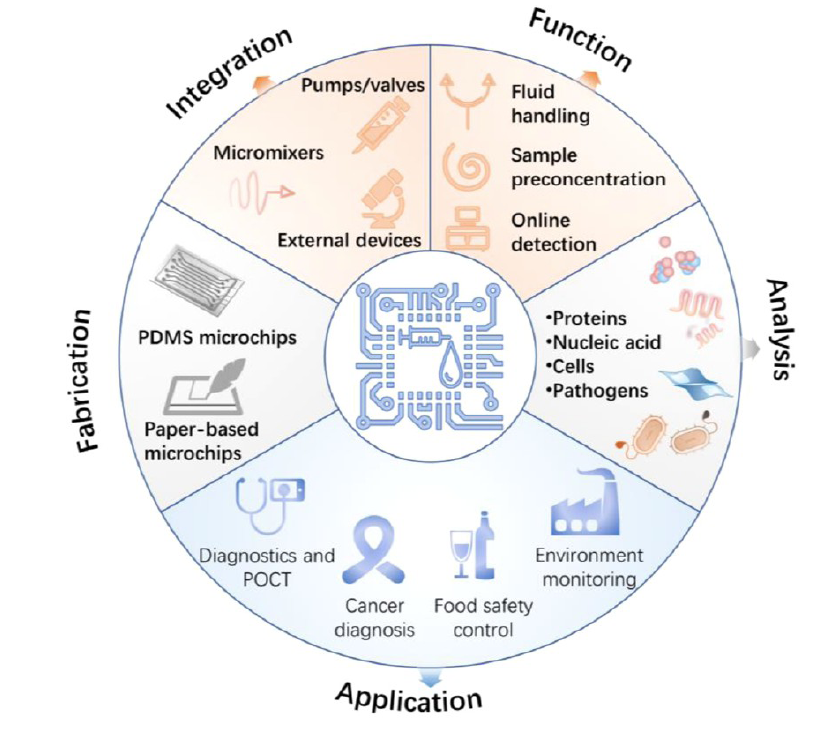博文
Microfluidics-Based Sensing of Biospecies
|
Microfluidics-Based Sensing of Biospecies
Yanlong Xing【邢艳珑】,‡ Linlu Zhao【赵琳璐】,‡ Ziyi Cheng【程子译】, Chuanzhu Lv【吕传柱】,* Feifei Yu,* and Fabiao Yu【于法标】*
Key Laboratory of Emergency and Trauma, Ministry of Education, Key Laboratory of Hainan Trauma
and Disaster Rescue, The First Affiliated Hospital of Hainan Medical University, College of Pharmacy, Institute of Functional Materials and Molecular Imaging, College of Emergency and Trauma, Hainan Medical University, Haikou 571199,
ABSTRACT: Over the past decades, microfluidic devices based on many advanced techniques have aroused widespread attention in the fields of chemical, biological, and analytical applications. Integration of microdevices with a variety of chip designs will facilitate promising functionality. Notably, the combination of microfluidics with functional nanomaterials may provide creative ideas to achieve rapid and sensitive detection of various biospecies. In this review, focused on the icrofluids and microdevices in terms of their fabrication, integration, and functions, we summarize the up-to-date developments in microfluidics-based analysis of biospecies, where biomarkers, small molecules, cells, and pathogens as representative biospecies have been explored in-depth. The promising applications of microfluidic biosensors including clinical diagnosis, food safety control, and environmental monitoring are also discussed. This review aims to highlight the importance of microfluidics-based biosensors in achieving high throughput, highly sensitive, and low-cost analysis and to promote microfluidics toward a wider range of applications.
KEYWORDS: microfluidic chip, functional nanomaterials, disease diagnosis, point-of-care test, analysis of biospecies
Cite this: ACS Appl. Bio Mater. 2020, XXXX, XXX, XXX-XXX
Publication Date:November 16, 2020
https://doi.org/10.1021/acsabm.0c01271
Copyright © 2020 American Chemical Society

Figure 1. Schematic illustration of the fabrication, integration, and function of microfluidic devices, the microfluidics-based analysis of biospecies, and various applications.
CONCLUSION AND FUTURE PERSPECTIVES
The microfluidic chip-based platform has progressed substantially since it possesses many attractive advantages such as low reagent consumption, fast sample processing, high integration, small size, and low cost, which enables a wide range of applications in the fields of liquid biopsy, single cell analysis, nucleic acid detection, drug screening, organ chip, and environmental and biochemical analysis. Focusing on the microfluids and microdevices in terms of their fabrication, integration, and functions, this review has outlined the latest developments in microfluidics-based analysis of biospecies, including biomarkers, small molecules, cells, and pathogens, and has also presented relatively promising applications based on microfluidic biosensors ranging from clinical diagnosis to food safety control and environmental monitoring (Table 1). Up to now, the fabrication of functional microfluidics has been extensively studied and the constructed microdevices have been proven to be promising in promoting the detecting efficacy and accuracy of biospecies.
Despite the great progress which has been made in microfluidics, there still exist many challenges and limitations that hinder the further development of microfluidics beyond academics. For instance, microfluidics-based sensing has limitations in device miniaturization and integration due to the requirements of external instruments, which makes it difficult for application in resource-restricted conditions. Additionally, the accuracy of microfluidic-based sensing of a single analyte need to be verified. In view of this, two further directions in microfluidics should be attended to from the
perspective of the whole field. (i) Integration of multi-nanotechnologies and novel materials. Many samples in clinical diagnosis and environment monitoring are quite complex, where there exist many kinds of different substances that may interfere with the detection process due to the strong background signal. Integration of advanced nanotechnologies could benefit to sample enrichment, and the selected materials for signal translation together may greatly improve the efficacy of microfluidics-based sensing. (ii) Simultaneous analysis of multiple significant biomarkers. For clinical diagnosis, therapy, and prognosis, it is essential to perform multiple parameter detection to ensure accurate evaluation. Therefore, combining multiple candidates such as proteins, nuclei acids, and other biomarkers into a single platform in a completely automated manner may not only provide valuable information about the disease but also promote the practical application in truly POCT to improve detection credibility. It is anticipated that the rationally designed microfluidic chip combined with advanced techniques and multifunctional materials will facilitate the realization of extensive clinical applications.
https://blog.sciencenet.cn/blog-2438823-1266310.html
上一篇:Naphthorhodafluor fluorescent probe for hydrogen polysulfide
下一篇:Tumor Specific Functional Nanomaterials for Bio-Applications
全部作者的其他最新博文
- • Triphenylamine-AIE Materials for Cancer Theranostics
- • Fluorescent Probe forRatiometric Monitoring of Peroxynitrite
- • Fluorescence Probe for Pathological Stages of Wound Healing
- • Macrophage M2 polarization to neurological damage
- • SERS-RCA biosensor for profiling dual miRNAs
- • a glutathione-activated near-infrared fluorescent probe